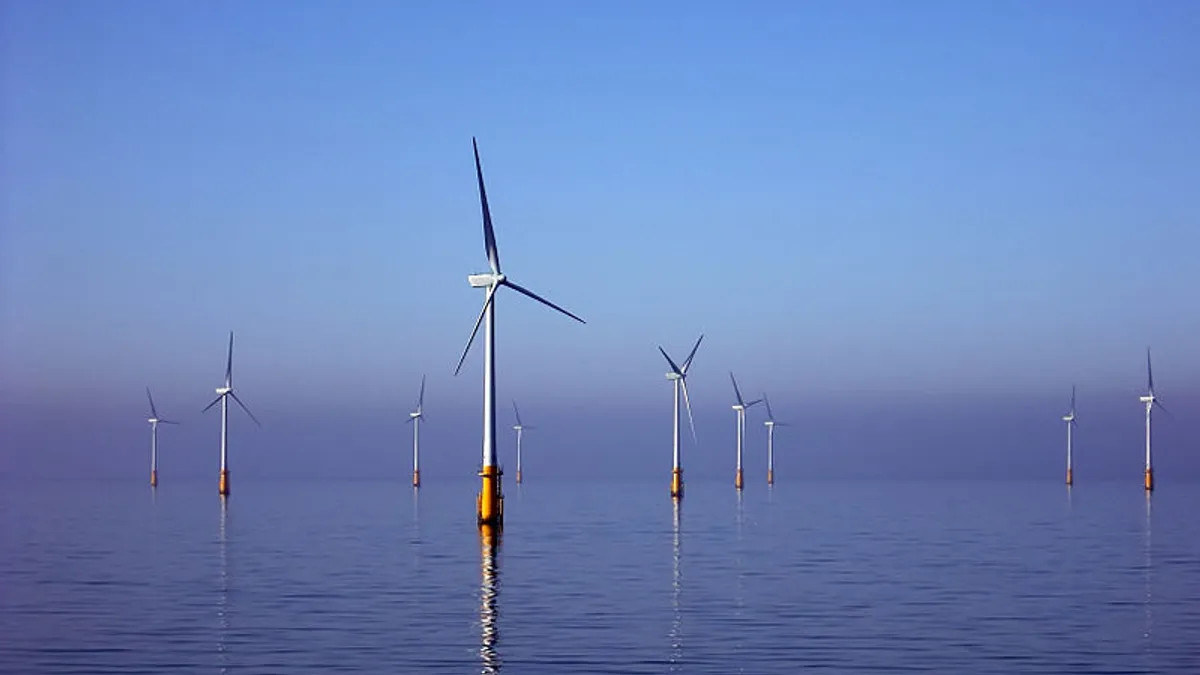Dive Brief:
-
Capacity market prices dropped in ISO-New England’s annual auction held Monday, but the owners of an offshore wind facility say they would have been lower had it been allowed to fully participate in the market.
-
ISO-NE said its 13th auction cleared 34.8 GW of capacity at a price of $3.80/kWh month, despite the planned 800 MW Vineyard Wind facility being denied a special renewable energy status that would have allowed it to bid at lower prices. The auction allocated capacity for delivery in 2022-2023.
-
Vineyard, which unsuccessfully pressed federal authorities for an auction delay, said its full participation would have "tripled the amount of new renewable resources awarded in the auction while simultaneously lowering prices for consumers." ISO-NE said it has changed its market rules to allow it and other offshore facilities to fully participate in the grid operator's next capacity auction.
Dive Insight:
ISO-NE's capacity auction this week illustrated how grid operators nationwide are struggling to integrate resources supported by government subsidies or mandates, like offshore wind.
In ISO-NE's capacity auction this year, a limited amount of renewable resources were allowed to apply for special "renewable technology resource (RTR)" that would allow them to be exempt from the market's price floor, the Minimum Offer Price Rule.
Vineyard Wind sought RTR status, but was prohibited by a provision in ISO-NE's tariff that limited RTR status to resources within the physical borders of a New England state. On Dec. 14, it asked FERC to waive those conditions and allow it to gain RTR status.
FERC declined to act on that request by the end of January, when it approved other changes to the ISO-NE market, leading Vineyard Wind to file an emergency request for an auction delay on Monday.
FERC passed on that request as well, sparking a social media flap between Democrat commissioners and Republican Chairman Neil Chatterjee.
Had Vineyard Wind been allowed to participate as an RTR resource, it would have likely entered a zero-dollar bid into the capacity market and been awarded the market clearing price for its capacity contribution.
That action would have lowered market prices for the fossil fuel power plants that account for the vast majority of ISO-NE capacity. Earlier this week, a trade group for New England power generators estimated that granting Vineyard Wind RTR status would "lower the clearing price paid to all resources would be reduced by $0.667 kW-month."
"When applied to the total clearing of the auction of approximately 34,000 MW, the impact (harm) to all capacity suppliers would exceed $270,000,000," the New England Power Generators Association wrote in response to Vineyard’s emergency request.
Vineyard Wind did not quantify its potential impact on market prices in a statement to Utility Dive, but said consumers "lost out on an opportunity to achieve the lowest bid pricing because Vineyard Wind was denied the opportunity to participate on the same terms as other renewable resources.”
Vineyard Wind was not shut out of the capacity market completely, ISO-NE said. The planned offshore facility was awarded a 54 MW capacity commitment that was transferred over from an unnamed retiring power plant. Changes to ISO-NE’s market rules approved last year — the Competitive Auctions with Sponsored Policy Resources (CASPR) initiative — allow such transfer of capacity credits.
"The absence of a renewable technology exemption does not prevent a resource from participating in the primary auction, substitution auction, or subsequent reconfiguration auctions,' ISO-NE spokesperson Marcia Blomberg told Utility Dive via email.
More than 145 MW of RTR resources participated in the auction, ISO-NE said in a statement, leaving more than 300 MW of unused RTR exemptions that will be carried over to next year, allowing more renewables to be exempt from the price floor. Blomberg said the ISO has already changed its tariff to allow Vineyard and other offshore wind to earn the exemption
"The renewable technology exemption that Vineyard Wind seeks will be available to eligible renewable resources in the 14th Forward Capacity Market auction, to be held Feb. 3, 2020," Blomberg wrote. "ISO New England has made changes to its tariff to ensure that offshore wind projects that will be located in federal waters, such as Vineyard Wind, would be eligible for the renewable technology exemption.”
Regardless of the capacity market situation, Vineyard Wind said this week it will continue construction of its project. The facility already has contracts with distribution utilities in Massachusetts, who face a 1,600 MW offshore wind mandate.
In all, the capacity auction cleared 34,839 MW to meet a capacity target of 33,750 MW for 2022-2023. That included 29,611 MW of generation, including 783 MW of new resources in the primary auction and 54 MW of new resources in the substitution auction, the latter referring to the Vineyard contribution.
The auction also cleared 4,040 MW of energy efficiency and demand-side management measures, including 654 MW of new resources. More than 2,000 MW of resources submitted retirement bids.
Auction prices fell to $3.80/kW-month, compared to $4.63/kW-month in the 2018 auction, $5.30/kW-month in 2017 and $7.03/kW-month in 2016.
The 2019 price did not include a meaningful bid from one large gas plant — Exelon's Mystic Generating Station in Boston — which was awarded price-taker status in the auction after winning ratepayer cost recovery from FERC this year. Other generators opposed that move, saying it would depress market prices.
The ISO-NE capacity auction also delivered a notable breakthrough for the market — its first capacity award to an aggregation of distributed resources. The 20 MW capacity commitment will be filled by solar installer Sunrun, which plans to deploy solar-plus-storage systems at roughly 5,000 homes.













